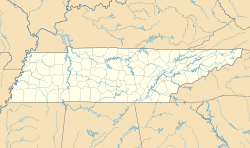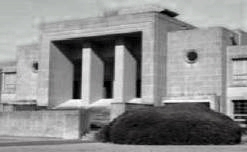Baron Hirsch Synagogue facts for kids
Quick facts for kids Baron Hirsch Synagogue |
|
|---|---|
| Religion | |
| Affiliation | Modern Orthodox Judaism |
| Ecclesiastical or organizational status | Synagogue |
| Leadership | Rabbi Ian Lichter |
| Status | Active |
| Location | |
| Location | 400 South Yates Road, Memphis, Tennessee |
| Country | United States |
| Architecture | |
| Date established | c. 1862 – c. 1864 (as a congregation) |
| Completed |
|
The Baron Hirsch Synagogue is a large Jewish place of worship, called a synagogue, in Memphis, Tennessee. It follows Modern Orthodox Judaism. The congregation started around 1862 or 1864. It grew a lot in the early 1900s. By the 1950s, it became the biggest Orthodox Jewish community in North America, and it still is today.
Its old building, at 1740 Vollintine Avenue, is a cool example of International Style architecture from the 1950s. This building is part of a U.S. Historic District. It is the main building in the Vollintine Hills Historic District. This district has 78 homes built around the synagogue by its members after World War II.
Contents
History of the Synagogue
Early Years in Memphis (1860s–1910)
The first Jewish community in Memphis formed downtown. This area was known as the "Pinch District." It was a place where many immigrants settled.
When the Baron Hirsch congregation first started in the 1860s, they did not have their own building. Around 1884, a group of Jewish immigrants who wanted to follow Orthodox traditions began to pray together. They met in rooms above stores, in private homes, and in a hotel. Rabbi I. Myerowitz was their first spiritual leader from 1891 to 1893.
Around 1890 or 1892, the group officially became the Baron Hirsch Benevolent Society. They named it after Baron Moritz de Hirsch, a famous Jewish helper from France.
In the same year, they bought an old church in the Pinch District. It was at 4th Street and Washington Avenue. They used it as their synagogue until 1912. In 1904, the group had 85 members.
Growing Stronger (1910–1920s)
The Baron Hirsch congregation kept growing. They soon tore down their old building. In 1915, they built a new synagogue on the same spot. This new building cost $35,000.
The main prayer hall in the new synagogue could hold over 700 people. It was still in the downtown Pinch district. In 1928, the congregation built the Menorah Institute next to the synagogue. This building had classrooms and space for social events. This building was taken down after the congregation moved in the 1950s.
By 1920, about 7,000 Jewish people lived in Memphis.
Moving East (1930s–1940s)
In the 1930s, many Jewish families in Memphis started moving east. They left the Pinch and other downtown areas. They moved to new neighborhoods in Midtown, like Vollintine-Evergreen. Many members kept small apartments downtown to be close to the synagogue for the Sabbath.
The congregation faced some challenges during the Great Depression. However, by 1941, Baron Hirsch had 500 families as members. Its religious school had 300 children.
During World War II, the Menorah Institute helped soldiers. Part of the building became a USO Center. Soldiers could sleep there. The outdoor area between the synagogue and the Menorah Institute was paved. It was used for USO dances.
A New Home (1950s)
After World War II, the congregation grew even more. Rabbi Isadore Goodman led them. By the late 1950s, they had over 1000 families. Their school had 500 children. This huge growth meant they needed a bigger synagogue. Also, many Jewish families had moved out of the downtown Pinch area.
They built the huge new synagogue in two parts. The first part was from 1950 to 1952. The second part was from 1955 to 1957. It was built on a 12.4-acre plot of land. This land used to be a golf course in midtown Memphis. It is now part of the Vollintine Hills Historic District.
The main prayer hall had 2200 permanent seats. It could fit 1000 more people if needed. When it was finished in 1957, it was the largest synagogue in the United States. This was confirmed by the Union of Orthodox Jewish Congregations of America.
The new building cost $1,600,000. It was designed in the International Style by architect George Awsumb. It had strong gray limestone walls and clean, modern lines. Jack Grue designed the beautiful stained glass windows.
Building this new synagogue helped create a special area. Many new homes for members were built nearby. People could walk to the synagogue. This area is now on the National Register of Historic Places. It is called the Vollintine Hills Historic District.
The congregation's membership doubled in the new synagogue. It became the largest Orthodox congregation in the United States. This showed how strong Orthodox Judaism was in Memphis. It also showed that many people in Memphis, both Jewish and Christian, were part of a religious group. Across the United States in the 1950s, more people joined churches and synagogues. The country's population grew by 40% from the 1930s to the 1950s. But church and synagogue membership grew by 50%.
Recent Changes and Current Status
Over time, the neighborhood around the synagogue changed. Members kept moving to the eastern suburbs of Memphis. The congregation needed to find another location. They wanted to be within walking distance for most of their members.
Under Rabbi Rafael G. Grossman, the congregation started to move from its midtown building. Baron Hirsch bought the home of musician Isaac Hayes. They turned the mansion into a smaller, satellite campus. By the mid-1980s, almost all Baron Hirsch members lived in this new area. So, they decided the whole synagogue complex should move.
They bought more land next to the satellite site. They started another building project. The large new synagogue and campus on South Yates Road was finished in 1988.
Today, the Baron Hirsch Synagogue is still active. It is a Modern Orthodox Zionist congregation. It is not as big as it was after World War II, but it continues to do well.
Rabbi Ian Lichter is the Senior Rabbi. Cantor Ricky Kampf leads the weekly services.
The Baron Hirsch Synagogue keeps adding to its community. In recent years, it added a large outdoor space. This is the Mendelson Park and Playground. The synagogue also completed a big project in 2022 to improve its buildings. They also built the new Memphis Mikvah at Baron Hirsch, which was also finished in 2022.
Images for kids




